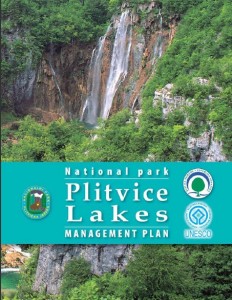Plitvice Lakes
1. Plitvice Lakes National Park [UNESCO World Heritage site]
As an area of the exceptional natural beauty, the Plitvice Lakes were proclaimed a national park in 1949, although the respected scientist Ivo Pevalek, who was among the first to study the phenomenon of tufa formation, had continually stressed the importance of their protection since 1926. The Plitvice Lakes constitute the oldest and best known Croatian national park, whose uniqueness was recognized at the global level – the Plitvice Lakes were registered in the UNESCO World Heritage List in 1979.
Some of this uniqueness is emphasized in the logo of the Park, depicting a waterfall and a lake, symbolizing the basic phenomenon that was a reason for its designation as a national park in the first place, while the bear, as the Park’s most attractive animal species, and the forest indicate the Park’s rich biodiversity.
The Park is situated in the inland mountain region of Croatia (about 60 km in a straight line from the sea), between the high mountains of Mala Kapela in the southwest and Lička Plješivica in the northeast, or more precisely, between 44° 44’ 34” and 44° 57’ 48” north latitude and 15° 27’ 32” and 15° 42’ 23” east longitude.
The Plitvice Lakes are a specific geological and hydrological karst phenomenon. Its basic feature is a chain of lakes connected by waterfalls, created by the biodynamic process of tufa development. Placed within the forested karst landscape, the sixteen larger and smaller lakes are interconnected with foaming cascades and waterfalls. The continuous process of tufa deposition, where certain plants (algae and mosses play a significant role) cause the barriers between the lakes to grow and form new waterfalls, curtains and cascades, thus maintaining the form and existence of the Plitvice Lakes.
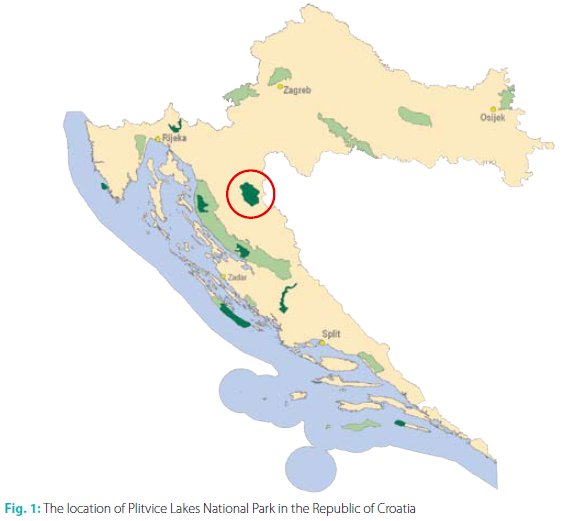
The most beautiful virgin forest of the Dinaric Alps, Čorkova Uvala, is located here. Due to its extraordinary value, this beech and fir forest was proclaimed a special forest reserve. The interplay between the geographical position, horizontal and vertical stratification and geological and pedological particularities creates a rich and diverse flora in the Park, with many rare, endemic and endangered species. So far 1,448 plant taxa have been recoded, 50 of them represent various orchid species and many of them endemic. In Croatia, some species are so far found only here, such as Siberian Rayflower (Ligularia sibirica). A rare and interesting plant is a species of hawksbeard (Crepis conyzifolia) that forms the special grassland association Crepido conyzifoliae-Molinietum altissimae (Šegulja,1992). Only two locations in Croatia for this association have been reported in the literature.
The local animal life is also rich and diverse. There are records of four large carnivores in the Park: brown bear, lynx, wolf and wild cat. Additionally, Plitvice Lakes National Park is the only national park in Croatia where the Italian crested newt (Triturus carnifex), alpine or black salamander (Salamandra atra), harvest mouse (Micromys minutus), striped field mouse (Apodemus agrarius) and whiskered bat (Myotis alcathoe) can be found. This record of the whiskered bat is the first and the only one in Croatia so far. The cultural and architectural heritage confirms the presence of human activity in this area, characterized by a number of traditional buildings, house yards and hamlets as well as villages and memorial sites.
Plitvice Lakes National Park accords great importance to scientific research. In this context, the establishment o the Biological Station in 1961 was a major step. In 1975, the Ivo Pevalek Research Station was established with the same objectives but at a different location. Since 1976, all scientific research has been conducted as part of a program called “Plitvice Research Project,” with costs covered by the National Park’s annual budget. For the first time, research proceeded within the framework of a long-term and complex research program conducted largely by the staff of the Ivo Pevalek Research Station in the National Park. The Plitvice Research Project constitutes a coherent whole. The themes were interconnected by the internal logic of a single idea, while the project’s objective is to observe the phenomenon of the Plitvice Lakes, both from the standpoint of fundamental knowledge and practical use under the conditions of the National Park.
The 1980s ere time of intense scientific interest in the actual waters of the Plitvice Lakes. In 1982, the Srdoč and associates team launched systematic measurements of the physical and chemical parameters, which later formed the basis for an explanation of the conditions required for tufa formation. At the same time, saprobiological, limnological and zoological research was conducted parallel to botanical and forestry research into the meadow and forest ecosystems.
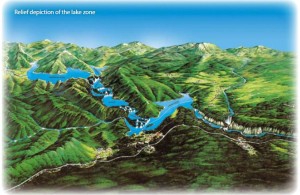
Ater the end of the period of occupation management and the local population and visitors to the Plitvice Lakes, research resu and Homeland War, and the return of the Park’s med with the financial support of the National Park through an integral project “Environmental Assessment of Water Resources,” as well as several inventory projects and, more recently, forestry and hydrological research projects. The work of the former Research Station continued within the frame work of the Ivo Pevalek Research and Conservation Center in a building newly constructed in 1999 and opened in 2003.
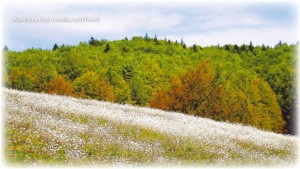 The Park has established sound cooperation with many institutions, non-governmental organizations and individuals at the national and international levels, and from 2003 to 2007 it was encompassed by the “Karst Ecosystem Conservation” (KEC) Project sponsored by the World Bank and the Croatian Government and the ministry in charge of environmental protection.
The Park has established sound cooperation with many institutions, non-governmental organizations and individuals at the national and international levels, and from 2003 to 2007 it was encompassed by the “Karst Ecosystem Conservation” (KEC) Project sponsored by the World Bank and the Croatian Government and the ministry in charge of environmental protection. 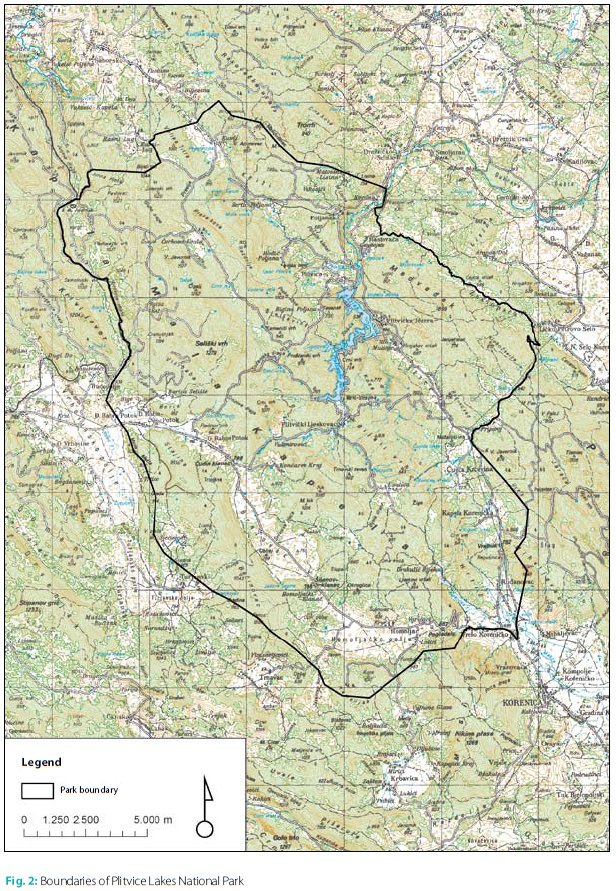
2. Plitvice Lakes National Park in the international context
The Republic of Croatia is a signatory to all relevant international treaties in the field of nature conservation at the global level. One of the fundamental covenants is the Convention on Biological Diversity that Croatia ratified in April 1996 (as published in Croatia’s official journal, Narodne novine, International Treaties edition, no. 6/96) and it has undertaken the commitment to safeguard existing biodiversity and to sustainably use its components. The karst tracts of the Croatian highlands constitute a natural resource of exceptional value to Europe and the world. The area is rich in endemic species and habitats, and the morphology and hydrology of the terrain are very specific. Although Croatia’s karst zones are relatively well preserved, especially in highland Croatia, they require, due to their extreme vulnerability, special attention in terms of strategic development planning and incorporation of biological and landscape diversity measures into all human activities in this region. It is precisely due to the aforementioned reasons that Plitvice Lakes National Park became a beneficiary of Karst Ecosystem Conservation (KEC) Project funds via a grant (IBRD GEF TF 050539 HR) from the Global Environmental Fund (GEF). The basic objective of this project is to safeguard biodiversity and facilitate sustainable development in local communities based on available natural wealth. This included the enhancement of institutional and professional capacity to conserve biodiversity, improve management of protected areas and promote business and tourism that uphold sustainable use and conservation of natural resources. Within the framework of the Ecological Network, Plitvice Lakes National Park has been designated as a core of international importance, and it also constitutes a potential area of the Natura 2000 Ecological Network. The international significance of Plitvice Lakes National Park as a unique natural treasure at the global level was acknowledged in 1979, when the United Nations, via UNESCO, placed it on the World Heritage List.
Vision of Plitvice Lakes National Park
The vision of Plitvice Lakes National Park brings together all groups and parties interested in securing a quality future for both the National Park and the local community, as well as all other concerned stakeholders. All of the Park’s management activities must comply in their entirety with this vision, for it reflects the purpose of the National Park’s existence and its management objectives. Plitvice Lakes National Park shall remain a UNESCO World Heritage site, and a national leader in the conservation and promotion of unique natural and cultural resources in their valorization by means of sustainable tourism to the benefit of the region and local communities and to the satisfaction of visitors. The Park is the driver of regional sustainable development which offers new experiences to visitors, particularly given the unique aspects of its natural environment and recreational possibilities. The vision statement also emphasizes the Park’s education function. The vision statement constitutes the foundation for developmental decision-making in the Park, and all activities must lead to its actualization. To achieve this vision, the following long-term objectives have been set:
- Preserve the unique karst biological diversity by facilitating natural processes and securing protection of the area with negligible human impact.
- Cooperation between the local community and the Park’s management to plan and implement local development.
- Secure visitor access to the authentic experience of the National Park’s value.
These objectives defined during the Plan’s preparation reflect the original aims for which the Park was created, namely the conservation of nature with emphasis on the lakes and tufa formation and the possibilities of visitor education and recreation. A new aspect introduced by this Management Plan is wilderness conservation as a special feature of the National Park and its potential role as a resource base for sustainable development of the local community and the latter’s active involvement in conservation and management of the protected area. Plitvice Lakes National Park is characterized by a highly valuable and diverse landscape with pristine and unaltered karst features. Large parts of the Park have not been actively used for several decades, while a smaller portion was subject to considerable human activity (e.g. meadows and grasslands). It is obvious that the Park’s territory will change with time, but all stakeholders involved in the Park’s administration must ensure that this change is managed such that the National Park retains its importance and natural value and cultural heritage. The three fundamental objectives foreseen for the long-term sustainable management of the Park are:
- Conservation – to conserve biological and landscape diversity and the cultural heritage in perpetuity.
- Education and recreation – to promote understanding of the importance of conservation and protection of its natural value and cultural heritage, and enjoyment of the pristine natural environment and other specific qualities of the Park.
- Strengthening the local community – to reinforce cooperation initiated with the local community in sustainable use of the Park’s natural resources with the objective of local and regional economic growth and development, ensuring income for the local community and the creation of new jobs.
3. CURRENT STATUS AND VALUE OF PLITVICE LAKES NATIONAL PARK
Institutional and legislative framework
Nature conservation in Croatia is regulated by a large number of legal instruments. The fundamental legislation governing the conservation of biological and landscape diversity is the Nature Protection Act (as published in Croatia’s official journal, Narodne novine, no. 70/05). This law defines the categories of protected areas, the methods for management thereof, in this regard, and the basic relevant documents. National parks and nature parks are managed by public institutions established by the Croatian Government. The obligation to draft management plans is stipulated by Article 80 of the aforementioned law. The management plan is adopted by the public institution’s Governing Board after securing consent from the Ministry of Culture and technical approval by the State Institute for Nature Protection, for a period of 10 years. Public hearings must be held during development of such plans. The management plan is implemented in practice through annual programs of conservation, use and promotion of the protected area.
Nature Protection Act – Narodne novine, no. 70/05 Article 80 1) Management of strict reserves, national parks, nature parks, regional parks, special reserves and protected landscapes shall be based on management plans. 2) The management plan shall be adopted for a period of ten years. 3) The management plan shall specify developmental guidelines, protection methods, use and management of the protected area, including detailed guidelines for protection and conservation of its natural values, respecting the needs of the local population. 4) The management plan shall be binding for all natural and legal persons engaged in activities within the protected area. 5) Upon the close of a five-year period, implementation of the management plan and the results achieved shall be analysed and, if necessary, the management plan shall be revised in the manner and under procedures as determined for the adoption thereof.
In addition to the management plan and the annual operating programs, the management of a protected area is regulated by internal regulations which define measures for protection, conservation, improvement and use pertaining to the protected area.
Besides the Nature Protection Act, during development of this Plan, all effective laws and subordinate regulations and documents governing management of protected areas were taken into account.
Planning instruments in Croatia
The Croatian Parliament proclaims national parks and nature parks and enacts physical plans for areas with specific features, national parks and nature parks. Physical plans have been mandatory since the 1970s as the core planning and conservation instrument for protected areas in Croatia. They are developed by the county physical planning departments which are under the jurisdiction of the Ministry of Environmental Protection, Physical Planning and Construction. Physical plans encompass the organization, use and purpose of a given area, as well as the conservation policies for specific areas of parks as well as zoning according to various types of usages. Since physical plans for protected areas are approved by the Croatian Parliament, they constitute fundamental legal documents for the management of national and nature parks in Croatia.
Plitvice Lakes National Park’s Physical Plan was drawn up by the Urban Planning Institute of Croatia in 1986. The development of a new Physical Plan for Plitvice Lakes National Park commenced during 2005. Over the past year, the Conservation Department of the Ministry of Culture completed its Conservation Study, which should form the foundation for formulating the enabling provisions of the Physical Plan. The conservation platform (guidelines) for developing the Physical Plan, which should be done by the State Institute for Nature Protection, has not yet been completed.
A study on construction development land in the National Park’s territory is currently being compiled by the Urban Planning Institute in Zagreb, which is also drafting the Physical Plan. The Management Plan was developed in cooperation with the State Institute for Nature Protection so that it can be aligned with the Physical Plan currently being prepared.
Responsible ministries and institutions
Nature protection and all activities related to management of the protected areas were under the authority of the Ministry of Environmental Protection and Physical Planning until the beginning of 2004. After public administration reform in January 2004, all activities related to nature protection were transferred to the jurisdiction of the Ministry of Culture.
Ministry of Culture, through its Nature Protection Department, is responsible for implementation of the Nature Protection Act and international conventions governing nature protection, and it coordinates administrative and technical tasks pertaining to nature conservation and planning sustainable use of the natural heritage.
Ministry of Environmental Protection, Physical Planning and Construction, although not directly involved in the management planning process for protected areas, has great responsibility for the development of protected areas through coordination of preparation of physical plans in close cooperation with the county physical planning departments and through inspections thereof. The State Institute for Nature Protection performs expertise-based tasks pertaining to nature protection in the Republic of Croatia.
Throughout the preparation of the management plan, vital inputs from other ministries and regional and local governments were taken into account and addressed.
Plitvice Lakes National Park Public Institution – Organizational structure
The National Park is administered by the Public Institution under the authority of the Ministry of Culture. The Public Institution’s activities encompass protection, conservation and promotion of the National Park with the objective of safeguarding and preserving the authenticity of its natural environment, ensuring that natural processes proceed unimpeded and that natural resources are used sustainably and overseeing all nature protection criteria and measures in the protected area. Additionally, the Park owns and manages three hotels (Jezero, Plitvice and Bellevue) located in the Park, one hotel outside of the Park (Grabovac), two camps (Korana and Borje), a series of restaurants within the Park, shops in the Park’s territory and a number of residential buildings, facilities and utilities infrastructure.
The Villa Izvor is also located in the Park, but it is not in use and title to the facility has not been settled. Once its title issues are settled, it will become functional either by means of concession or lease. The Plitvice Motel in Lučko, near Zagreb, is also under the majority ownership of the Park’s Management. The Public Institution’s bodies are the Governing Board, Director General and Conservation Manager. The Governing Board makes the key developmental decisions, while the Institution’s operations are organized and administered by the Director General, who is appointed by the Minister for a four-year period. The Conservation Manager oversees the Institution’s conservation operations (conservation service). The internal structure and activities of the Institution are governed by the Charter and Internal Structure and Operating Rules. For the purpose of harmonious, professional and systematic performance of the Institution’s activities in managing Plitvice Lakes National Park, the Institution is divided into 2 services and 3 sectors which are administered by the Office of the Director General. The Institution’s internal organizational units are:
- Office of the Director General
- National Park Conservation, Promotion and Use Service
- Joint Operations Service
- Hotels and Hospitality Sector
- Maintenance and Utilities Sector
- Retail Outlets Sector
Within these departments, the Park currently employs a staff of over 730, of which approximately 130 perform conservation-related jobs. A small number of the Park’s activities are financed from the Central State Budget, while the rest are financed by the Park’s own revenues. The current organizational structure of Plitvice Lakes National Park is shown in Fig. 3.
Existing infrastructure
The Plitvice Lakes National Park Public Institution owns an entire series of buildings, land, hotels, restaurants, shops, offices and other infrastructure in the Park itself, in the region and elsewhere in Croatia. In the case of Plitvice Lakes National Park, the list of infrastructure would be too large for the confines of this Management Plan, so these data are not shown herein.
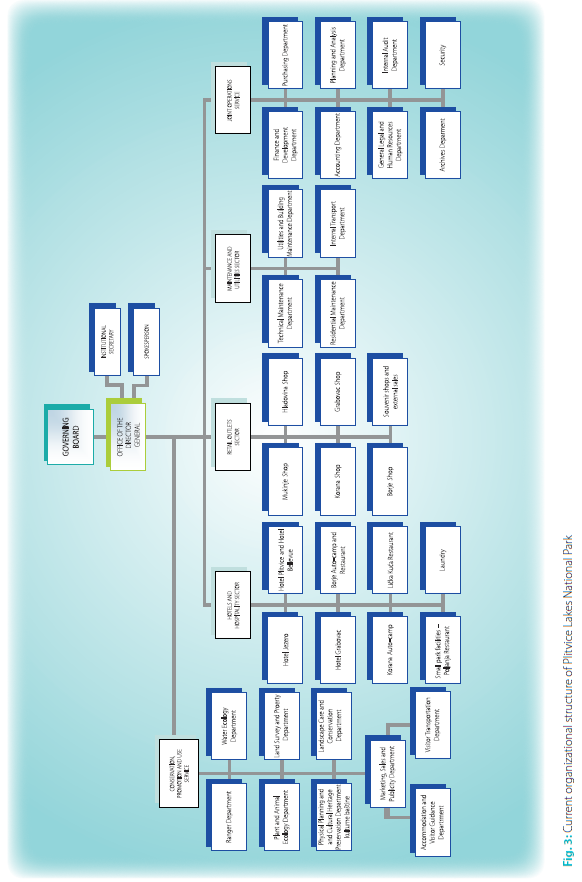
4. Related Project and Publications
“Anthropol.prot”
Contract number: ICA2-CT-2002-10009
Title:
STUDY OF ANTHROPOGENIC POLLUTION AFTER THE WAR AND ESTABLISHING THE MEASURES FOR PROTECTION OF PLITVICE NATIONAL PARK AND BIHAĆ REGION AT THE BORDER AREA OF CROATIA AND BOSNIA – HERZEGOVINA
By: Dr. Bogomil Obelic (IRB) and Prof. José Luis Briansó (UAB)
Project homepage: http://www.irb.hr/anthropol.prot/
or
http://www.irb.hr/en/research/projects/intl/euprojects/ICA2/
Partners:
- Partner 1 (UAB): Universitat Autónoma de Barcelona
- Partner 2 (GGA): Institut für Geowissentschaftliche Gemeinschaftsaufgaben, Hannover
- Partner 3 (RBIZ): Rudjer Bošković Institute, Zagreb
- Partner 4 (IGEO): Geological Institute, Zagreb
- Partner 5 (Geosurv): Geological Institute of BiH, Sarajevo
- Partner 6 (UBihac): Biotechnical Faculty, University of Bihać
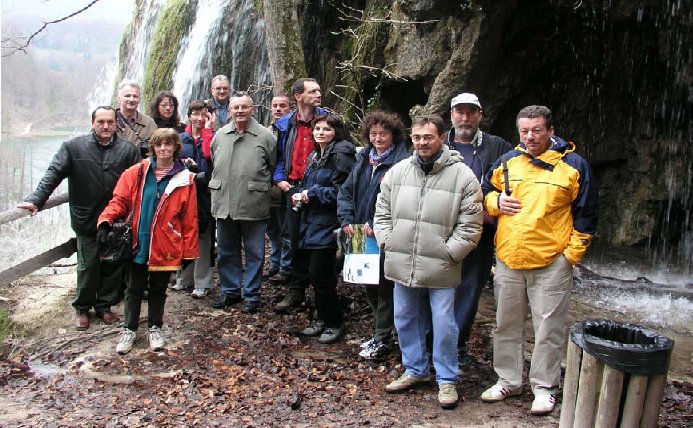
Participants in the Project at Plitvice Lakes National Park, April 2003
Publications and Papers
See: http://www.irb.hr/en/research/projects/intl/euprojects/ICA2/Dissemination/Articles/#l_Publications
-
Babinka, S., Suckow,A., Horvatinčić, N.: Anthropogenic Pollution in Croatian and Bosnian Karst Waters and Lake Sediments; – UNESCO – International Workshop on the Application of Isotope Techniques in Hydrological and Environmental Studies, Paris (France), Sept.6—10, 2004, Extended abstract, p.23-24.
-
Kapelj, J., Kapelj, S., Singer, D.: Spatial distribution of dolinas and its significance for groundwater protection in karst terrain; Proceedings of XXXIII IAH Congress & 7th Congress ALHSUD “Groundwater flow understanding from local to regional scales”, Zacatecas, México, Oct.11—15, 2004, La Octava Casa, 2004, Accepted for publication in proceedings.
-
Horvatinčić, N., Obelić, B., Barešić, J., Čalić, R., Babinka, S., Suckow, A,. Krajcar Bronić, I.: A geochemical and isotope hydrological study of eutrophication processes in the Plitvice Lakes, Croatia. International Conference on Isotopes in Environmental Studies – Aquatic Forum, Oct.25—29, 2004; Monte-Carlo, Monaco, Book of abstracts, 2004, p.133-134.
-
Horvatinčić, N., Barešić, J., Čalić, R., Obelić, B., Krajcar Bronić, I.: Utjecaj fizikalno-kemijskih svojstava voda an process eutrofikacije (Study of eutrophication process by physico-chemical measurements of water); XIX Croatian Meeting of Chemists and Chemical Engineers, Opatija (Croatia), April 24—27, 2005, Book of abstracts, 2005, p.420.
-
Babinka, S., Suckow, A., Horvatinčić, N, Kapelj, J., Kapelj, S.: Multi-Tracer Approach in Croatian and Bosnian Karst Waters and Lake Sediments., 6 Symposium on Applied Isotope Geochemistry AIG-6, Prague, Czech Republic, Sept.11th—16, 2005;, Book of abstracts, p. 30-32.
-
Obelić, B., Horvatinčić, N., Barešić, J., Briansó, J.L., Babinka, S., Suckow, A.: Anthropogenic pollution in karst lake sediments (Croatia); Proceedings of the 1st International Symposium on Travertine, Pamukkale Univ., Denizli (Turkey), Sept. 21—24, 2005., Proceedings, 2005, p. 188-196.
-
Babinka, S., Suckow, A., Horvatinčić, N, Kapelj, J., Kapelj, S.: Multi-Tracer Approach in the Karst Waters and Lake Sediments in the Plitvice Lakes and Una River. 3 Croatian Geological Congress, Sept.29rd—Oct.02, 2005; Opatija, Croatia, Book of extended abstracts, p.169-170.
-
Ahel, M., Terzić, S.: Molecular Markers of Anthropogenic Influence on Plitvice Lakes, Croatia, Abstract Volume of the 11th World Lake Conference, Nairobi, Kenya, Oct.31—Nov.4, 2005, Book of abstracts, 2005, p.47.
-
Horvatinčić, N., Briansó, J.L., Obelić, B., Barešić, J., Krajcar Bronić, I.: Study of eutrophication process in the Plitvice Lakes by water and sediment composition; RMZ – Materials and Geoenvironment, 52/1 (2005), p.241.
-
Horvatinčić, N., Briansó, J.L., Obelić, B., Barešić, J., Krajcar Bronić, I.: Study of eutrophication process in the Plitvice Lakes by water and sediment composition; Water Air Soil Poll. (2006), accepted for publication.
-
Babinka, S., Suckow, A.: Multi-tracer approach in Croatian and Bosnian Karst spring waters: National Park Plitvice and Bihać Area; Chem. Geology (2006), in preparation.
PRINTED BOOKS
-
Kapelj, J., Kapelj, S.: Short guidebook on hydrogeological relations in the Plitvice National Park and surrounding area; EUGEN 2005 Croatia-10th annual European Geology Students Network, Organisation EUGEN Deutchland e.V.- Croatian Geological Society, Excursion Guide Book, p.31-39, Zagreb, 2005.
-
Džankić, N., Makić, H., Budimlić, A.: Prirodni i antropogeni uticaj na kvalitet voda slivnog područja rijeke Une. (Natural and anthropogenic effect on the quality of the waters in the catchments basin of the Una River), Grafičar, Bihać, 2006, 270 pages, in press.

